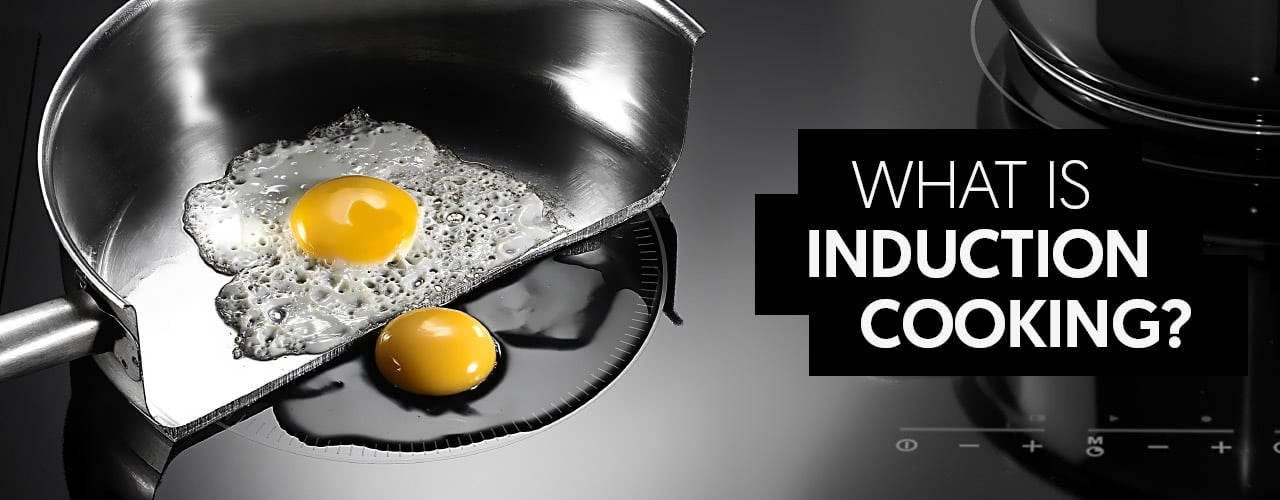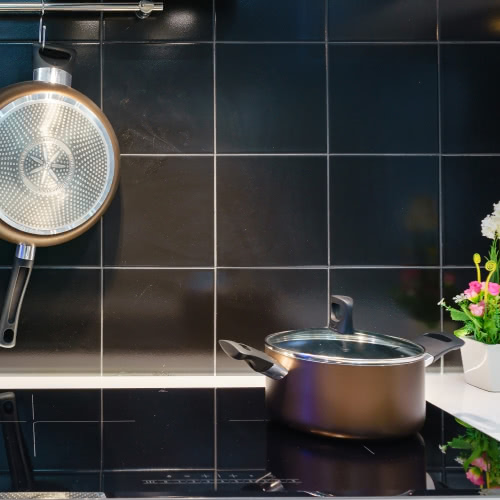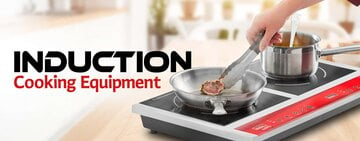
Whether you’re building a brand new restaurant or looking to remodel, it’s important to consider your options when it comes to what type of cooking equipment will be best for your business. Induction cooking has grown in popularity over the years, but the way it works and the benefits of using it are still a mystery to many. Keep reading to learn what induction cooking is and why it’s a popular choice amongst many restaurateurs.
What Is an Induction Cooktop?
An induction cooktop is a cooking surface that heats by transferring currents from an electromagnetic field located below the glass surface directly to the magnetic induction cookware placed above.
Unlike thermal conduction, it heats this cookware directly without the need for a flame or burner. Because there is no heating of a separate element, an induction cooktop can heat cookware faster than any other medium.
How Does Induction Cooking Work?
While gas and electric stoves heat cookware indirectly by first heating a coil, burner, or producing a flame, induction cooking provides direct heat to the cookware which then passes the radiant energy on to the food. Instead of a heating element, magnets are used to stimulate the atoms inside your cookware and heat the pot or pan.
Because induction cooking offers direct heat to cookware, it is an incredibly efficient option that gives the user more control over the cook than the traditional alternatives. Additionally, the heat is directly sourced, which means the temperature tends to stay much steadier than electric or gas ranges as well.
Here is a visual display of how an induction cooktop works:

What Types of Cookware Can Be Used with Induction Cooking?
Any cookware in your kitchen that features a magnetic base can be used on an induction cooktop surface. Common induction-compatible cookware includes cast iron and certain types of stainless steel. Stainless steel pots and pans that have had nickel added to them are non-magnetic and can't be used with induction cookware. Common types of magnetic stainless steel include 430 stainless steel and 18/0 grade. To test your current cookware, you can simply hold a magnet up to the bottom of the pot or pan. If it strongly sticks, then that piece will work. If you’re purchasing new cookware, look for any type of “induction compatible” labeling.
An induction stovetop will not work with non-magnetic materials such as copper or aluminum.
Is Induction Cooking Safe?
 Yes, induction cooking is a safe method of cooking. That’s because, unlike electric or gas ranges, the glass surface of an induction stove doesn’t get hot. This makes it a safe addition to any crowded kitchen, buffet service station, or catered event. Additionally, some induction cooking elements even feature an automatic shutoff once a pot or pan has been removed from the surface. It is advised, however, that those with a pacemaker avoid using induction cooktops because of the electromagnetic current.
Yes, induction cooking is a safe method of cooking. That’s because, unlike electric or gas ranges, the glass surface of an induction stove doesn’t get hot. This makes it a safe addition to any crowded kitchen, buffet service station, or catered event. Additionally, some induction cooking elements even feature an automatic shutoff once a pot or pan has been removed from the surface. It is advised, however, that those with a pacemaker avoid using induction cooktops because of the electromagnetic current.
Along the same lines, this energy-efficient cookware won’t heat up your kitchen or cooking area. That’s because all of the heat generated goes directly into the pan and not out into the ambient air.
Why Is Induction Cookware Growing in Popularity?
Induction cooking has always been popular in Europe, namely because of its energy-efficient design. Energy prices in the United States have typically been much lower than those in some European countries, making gas and electric cookware a more accessible option.
In addition, induction cooking equipment used to be considered quite expensive. But thanks to a recent demand in the U.S. market for more accessibility, the price has steadily dropped. This, along with the fact that restaurateurs, chefs, and diners alike are becoming increasingly concerned with energy efficiency in restaurants, has led to a rise in the use of induction cookware during the last few years.
Cooking Equipment Comparison
Read below to learn more about the difference between induction cookware and other popular cooking methods commonly used in restaurants.
Induction Vs. Gas
 A gas range is heated through the use of various gas sources including natural gas, propane, and butane. It is one of the most common types of cooking equipment in commercial kitchens. While induction stovetops require electricity to power them, gas cooktops are powered via gas and therefore require no electricity. This makes gas an ideal choice for remote locations, outdoor catered events, and kitchens looking to lower their electric usage.
A gas range is heated through the use of various gas sources including natural gas, propane, and butane. It is one of the most common types of cooking equipment in commercial kitchens. While induction stovetops require electricity to power them, gas cooktops are powered via gas and therefore require no electricity. This makes gas an ideal choice for remote locations, outdoor catered events, and kitchens looking to lower their electric usage.
Additionally, gas cooktops feature a flame that can instantly be made lower or higher with the turn of a dial. This control over the flame can provide a more instantaneous effect on the level of heat than the adjustments on induction cooktops.
Here are a few cons to using a gas cooktop:
- Grates can quickly become covered in food and grime, making it more of a hassle to clean
- Installation of new gas can require the assistance of a professional, making it a time consuming and costly process
- Potential for gas leaks if used or installed improperly
- Won’t get as hot as an induction cooktop
Induction Vs. Electric
An electric stovetop uses electricity to heat coiled elements or a ceramic radiant surface. It is typically less expensive and less hassle to install than induction or gas cooktops and requires very little maintenance. And unlike induction cooking, both gas and electric stovetops can be used with any type of cookware.
Electric cooktops are more energy-efficient than gas in terms of how much heat reaches the food, but still fall short of the 90% energy efficiency seen by induction cooktops. In general, electric cooktops require less upfront cost and no specialized cookware but are less responsive when it comes to temperature control.
Here are a few cons to using an electric cooktop:
- Surface gets very hot
- There’s a slow change in heat, which means less control over the temperature than gas or induction
- Won’t heat food as hot as gas or induction
Things to Consider About Induction Cooking
 There are many benefits to cooking with an induction stovetop. It’s fast, efficient, and won’t heat up your kitchen. But before you install a whole new cooktop, carefully consider the following:
There are many benefits to cooking with an induction stovetop. It’s fast, efficient, and won’t heat up your kitchen. But before you install a whole new cooktop, carefully consider the following:
- Its magnetic field can affect important electronics including digital thermometers.
- There are typically no visual cues that the burner is on, such as a physically hot surface, red coils, or a physical flame. This can confuse people and make them wary to try it.
- You’re limited in the type of cookware that can be used on it.
- Induction cooktops typically hum during use, which can become louder when higher heat settings are used.
Once chefs and restaurateurs have a better understanding of what induction cooking is and the benefits it can bring to their kitchen, they’re more likely to give this innovative technology a try. Its efficient and fast heating can be a huge asset to low- and high-volume kitchens alike. Consider incorporating induction cookware into your next big remodel or restaurant opening.





